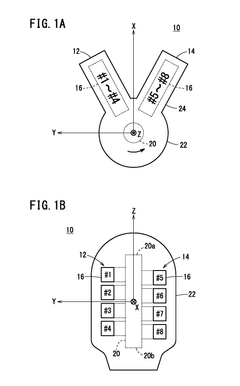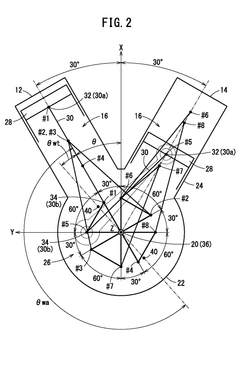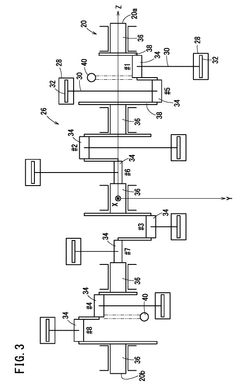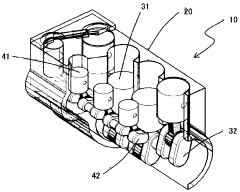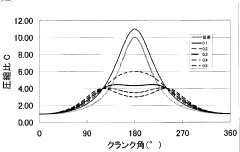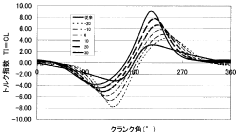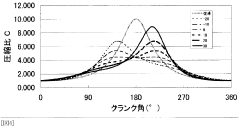How V8 Engines Achieve Optimal Torque: Insights?
JUL 4, 20258 MIN READ
Generate Your Research Report Instantly with AI Agent
Patsnap Eureka helps you evaluate technical feasibility & market potential.
V8 Engine Evolution
The V8 engine has undergone significant evolution since its inception in the early 20th century. Initially developed to provide more power and smoother operation than inline engines, V8s have become synonymous with high performance and luxury vehicles. The early V8 designs focused on increasing displacement and improving fuel delivery systems to enhance power output.
In the 1950s and 1960s, V8 engines saw rapid advancements in materials and manufacturing techniques. The introduction of overhead valve (OHV) designs and the widespread adoption of cross-flow cylinder heads marked significant milestones in V8 development. These innovations improved engine breathing and combustion efficiency, leading to increased power and torque output.
The 1970s brought new challenges with the oil crisis and stricter emission regulations. V8 engine designers responded by implementing electronic fuel injection systems and catalytic converters. These technologies allowed for better fuel economy and reduced emissions while maintaining performance. The introduction of computer-controlled engine management systems in the 1980s further refined V8 performance and efficiency.
The 1990s and early 2000s saw a shift towards more compact and efficient V8 designs. Manufacturers began implementing technologies such as variable valve timing, cylinder deactivation, and direct fuel injection. These advancements allowed V8 engines to deliver impressive power outputs while meeting increasingly stringent fuel economy and emissions standards.
In recent years, the focus has shifted towards achieving optimal torque across a broader range of engine speeds. This has led to the development of twin-turbocharging systems, which provide significant low-end torque while maintaining high-end power. Additionally, the integration of hybrid technologies with V8 engines has emerged as a way to further enhance performance and efficiency.
The latest V8 engines incorporate advanced materials such as aluminum and carbon fiber to reduce weight and improve thermal efficiency. Precision manufacturing techniques, including 3D printing for complex components, have enabled more intricate designs that optimize airflow and combustion dynamics. These developments have resulted in V8 engines that deliver exceptional torque characteristics while meeting modern performance, efficiency, and emissions requirements.
In the 1950s and 1960s, V8 engines saw rapid advancements in materials and manufacturing techniques. The introduction of overhead valve (OHV) designs and the widespread adoption of cross-flow cylinder heads marked significant milestones in V8 development. These innovations improved engine breathing and combustion efficiency, leading to increased power and torque output.
The 1970s brought new challenges with the oil crisis and stricter emission regulations. V8 engine designers responded by implementing electronic fuel injection systems and catalytic converters. These technologies allowed for better fuel economy and reduced emissions while maintaining performance. The introduction of computer-controlled engine management systems in the 1980s further refined V8 performance and efficiency.
The 1990s and early 2000s saw a shift towards more compact and efficient V8 designs. Manufacturers began implementing technologies such as variable valve timing, cylinder deactivation, and direct fuel injection. These advancements allowed V8 engines to deliver impressive power outputs while meeting increasingly stringent fuel economy and emissions standards.
In recent years, the focus has shifted towards achieving optimal torque across a broader range of engine speeds. This has led to the development of twin-turbocharging systems, which provide significant low-end torque while maintaining high-end power. Additionally, the integration of hybrid technologies with V8 engines has emerged as a way to further enhance performance and efficiency.
The latest V8 engines incorporate advanced materials such as aluminum and carbon fiber to reduce weight and improve thermal efficiency. Precision manufacturing techniques, including 3D printing for complex components, have enabled more intricate designs that optimize airflow and combustion dynamics. These developments have resulted in V8 engines that deliver exceptional torque characteristics while meeting modern performance, efficiency, and emissions requirements.
Market Demand Analysis
The market demand for V8 engines with optimal torque performance remains robust, driven by various factors in the automotive industry. High-performance vehicles, luxury cars, and certain commercial applications continue to rely on V8 engines for their power delivery and characteristic sound. The demand is particularly strong in regions where fuel efficiency regulations are less stringent, such as North America and the Middle East.
In the passenger car segment, V8 engines are predominantly found in premium and luxury vehicles, where customers prioritize performance and prestige over fuel economy. Sports cars and high-end sedans from manufacturers like Mercedes-Benz, BMW, and Audi maintain a significant market share for V8-powered vehicles. The racing and motorsport industry also contributes to the demand for V8 engines with optimal torque characteristics, as these powerplants are favored in various racing series.
The commercial vehicle sector, including heavy-duty trucks and specialized equipment, represents another significant market for V8 engines. In this segment, the focus on optimal torque is crucial for towing capacity and overall performance under heavy loads. Construction, mining, and agricultural industries rely on V8 engines for their durability and power output in demanding applications.
However, the market for V8 engines faces challenges due to increasing environmental regulations and a shift towards electrification. Many countries are implementing stricter emissions standards, pushing manufacturers to develop more efficient V8 engines or explore alternative powertrains. This has led to innovations in V8 technology, such as cylinder deactivation and advanced fuel injection systems, to improve fuel efficiency while maintaining performance.
The global trend towards downsizing and turbocharging has impacted the V8 engine market, with some manufacturers opting for smaller displacement engines with forced induction to achieve similar power outputs. Despite this, there remains a dedicated consumer base that values the unique characteristics of V8 engines, particularly in performance-oriented vehicles and luxury segments.
Emerging markets, especially in developing countries with growing middle and upper classes, present new opportunities for V8-powered vehicles. As disposable incomes rise, the demand for premium and high-performance vehicles increases, potentially offsetting some of the declines in traditional markets.
In conclusion, while facing challenges from environmental concerns and technological shifts, the market for V8 engines with optimal torque continues to thrive in specific segments. The ongoing demand is driven by performance enthusiasts, luxury car buyers, and commercial applications that require high torque output. Manufacturers are adapting to market pressures by developing more efficient V8 engines, ensuring their relevance in a changing automotive landscape.
In the passenger car segment, V8 engines are predominantly found in premium and luxury vehicles, where customers prioritize performance and prestige over fuel economy. Sports cars and high-end sedans from manufacturers like Mercedes-Benz, BMW, and Audi maintain a significant market share for V8-powered vehicles. The racing and motorsport industry also contributes to the demand for V8 engines with optimal torque characteristics, as these powerplants are favored in various racing series.
The commercial vehicle sector, including heavy-duty trucks and specialized equipment, represents another significant market for V8 engines. In this segment, the focus on optimal torque is crucial for towing capacity and overall performance under heavy loads. Construction, mining, and agricultural industries rely on V8 engines for their durability and power output in demanding applications.
However, the market for V8 engines faces challenges due to increasing environmental regulations and a shift towards electrification. Many countries are implementing stricter emissions standards, pushing manufacturers to develop more efficient V8 engines or explore alternative powertrains. This has led to innovations in V8 technology, such as cylinder deactivation and advanced fuel injection systems, to improve fuel efficiency while maintaining performance.
The global trend towards downsizing and turbocharging has impacted the V8 engine market, with some manufacturers opting for smaller displacement engines with forced induction to achieve similar power outputs. Despite this, there remains a dedicated consumer base that values the unique characteristics of V8 engines, particularly in performance-oriented vehicles and luxury segments.
Emerging markets, especially in developing countries with growing middle and upper classes, present new opportunities for V8-powered vehicles. As disposable incomes rise, the demand for premium and high-performance vehicles increases, potentially offsetting some of the declines in traditional markets.
In conclusion, while facing challenges from environmental concerns and technological shifts, the market for V8 engines with optimal torque continues to thrive in specific segments. The ongoing demand is driven by performance enthusiasts, luxury car buyers, and commercial applications that require high torque output. Manufacturers are adapting to market pressures by developing more efficient V8 engines, ensuring their relevance in a changing automotive landscape.
Technical Challenges
V8 engines face several technical challenges in achieving optimal torque. One of the primary issues is balancing power output with fuel efficiency. As manufacturers strive to meet increasingly stringent emissions regulations, they must find ways to maintain or improve engine performance while reducing fuel consumption and emissions. This often requires complex engine management systems and advanced fuel injection technologies.
Another significant challenge is managing heat and thermal efficiency. V8 engines generate substantial heat during operation, which can lead to reduced performance and increased wear if not properly managed. Engineers must develop innovative cooling systems and materials to dissipate heat effectively while maintaining optimal operating temperatures for maximum efficiency.
Vibration and noise control present additional hurdles for V8 engine designers. The inherent design of V8 engines can lead to increased vibration and noise compared to smaller engines. Addressing these issues requires sophisticated engine mounting systems, sound dampening materials, and precise balancing of rotating components.
Weight reduction is another critical challenge in V8 engine development. As automotive manufacturers aim to improve overall vehicle efficiency, reducing engine weight becomes crucial. However, this must be achieved without compromising structural integrity or performance, often necessitating the use of advanced materials and manufacturing techniques.
The complexity of modern V8 engines also poses challenges in terms of reliability and maintenance. With the integration of advanced technologies such as variable valve timing, direct injection, and turbocharging, these engines become more intricate and potentially more prone to issues. Ensuring long-term reliability while maintaining high performance is a constant balancing act for engineers.
Adapting V8 engines to alternative fuels and hybrid powertrains presents another set of technical challenges. As the automotive industry shifts towards more sustainable solutions, V8 engines must be designed to work efficiently with biofuels or as part of hybrid systems, which can require significant modifications to traditional designs.
Finally, optimizing torque across a wide range of engine speeds remains a persistent challenge. V8 engines are often praised for their low-end torque, but maintaining this advantage while also providing high-end power requires careful tuning of valve timing, intake and exhaust systems, and engine management software. Engineers must constantly innovate to achieve a balance that satisfies both performance enthusiasts and everyday drivers.
Another significant challenge is managing heat and thermal efficiency. V8 engines generate substantial heat during operation, which can lead to reduced performance and increased wear if not properly managed. Engineers must develop innovative cooling systems and materials to dissipate heat effectively while maintaining optimal operating temperatures for maximum efficiency.
Vibration and noise control present additional hurdles for V8 engine designers. The inherent design of V8 engines can lead to increased vibration and noise compared to smaller engines. Addressing these issues requires sophisticated engine mounting systems, sound dampening materials, and precise balancing of rotating components.
Weight reduction is another critical challenge in V8 engine development. As automotive manufacturers aim to improve overall vehicle efficiency, reducing engine weight becomes crucial. However, this must be achieved without compromising structural integrity or performance, often necessitating the use of advanced materials and manufacturing techniques.
The complexity of modern V8 engines also poses challenges in terms of reliability and maintenance. With the integration of advanced technologies such as variable valve timing, direct injection, and turbocharging, these engines become more intricate and potentially more prone to issues. Ensuring long-term reliability while maintaining high performance is a constant balancing act for engineers.
Adapting V8 engines to alternative fuels and hybrid powertrains presents another set of technical challenges. As the automotive industry shifts towards more sustainable solutions, V8 engines must be designed to work efficiently with biofuels or as part of hybrid systems, which can require significant modifications to traditional designs.
Finally, optimizing torque across a wide range of engine speeds remains a persistent challenge. V8 engines are often praised for their low-end torque, but maintaining this advantage while also providing high-end power requires careful tuning of valve timing, intake and exhaust systems, and engine management software. Engineers must constantly innovate to achieve a balance that satisfies both performance enthusiasts and everyday drivers.
Current Torque Solutions
01 Torque measurement and control in V8 engines
Various methods and systems are employed to measure and control torque in V8 engines. These include advanced sensors, electronic control units, and algorithms that analyze engine parameters to optimize torque output. Such systems can adjust fuel injection, ignition timing, and valve timing to maintain optimal torque across different operating conditions.- Torque measurement and control in V8 engines: Various methods and systems are employed to measure and control torque in V8 engines. These include advanced sensors, electronic control units, and algorithms that analyze engine parameters to optimize torque output. Such systems can adjust fuel injection, ignition timing, and valve timing to maintain optimal torque across different operating conditions.
- Improving V8 engine efficiency and performance: Techniques for enhancing V8 engine efficiency and performance focus on optimizing combustion processes, reducing friction, and improving thermal management. These may include advanced materials, cylinder deactivation systems, and variable valve timing mechanisms to balance power output with fuel economy.
- V8 engine torque management in vehicle applications: Torque management systems in vehicles with V8 engines are designed to enhance drivability, traction control, and overall vehicle dynamics. These systems integrate with transmission control units and stability control systems to optimize power delivery and handling characteristics across various driving conditions.
- Diagnostic and monitoring systems for V8 engine torque: Advanced diagnostic and monitoring systems are developed to assess V8 engine torque performance in real-time. These systems use a combination of sensors, data analysis, and predictive algorithms to detect anomalies, optimize maintenance schedules, and ensure consistent torque output throughout the engine's lifecycle.
- Environmental considerations in V8 engine torque design: Modern V8 engine designs incorporate features to balance high torque output with environmental concerns. This includes the development of more efficient combustion processes, integration of hybrid technologies, and the use of alternative fuels to reduce emissions while maintaining the characteristic power and torque of V8 engines.
02 Improving V8 engine torque characteristics
Techniques for enhancing torque characteristics in V8 engines focus on design modifications and advanced technologies. These may include variable valve timing, turbocharging, direct fuel injection, and cylinder deactivation. Such improvements aim to increase low-end torque, broaden the torque curve, and improve overall engine efficiency.Expand Specific Solutions03 Torque management in V8 engine vehicles
Torque management systems in vehicles with V8 engines are designed to optimize power delivery, traction, and fuel efficiency. These systems may include adaptive transmission control, torque vectoring, and electronic stability control. They work in conjunction with the engine management system to provide smooth acceleration and improved vehicle dynamics.Expand Specific Solutions04 V8 engine torque monitoring and diagnostics
Advanced diagnostic systems for V8 engines focus on real-time torque monitoring and fault detection. These systems use various sensors and data analysis techniques to identify torque-related issues, such as misfires, imbalances, or mechanical problems. They help in predictive maintenance and ensuring optimal engine performance.Expand Specific Solutions05 Torque-based calibration for V8 engines
Calibration methods based on torque output are crucial for optimizing V8 engine performance. These techniques involve mapping engine torque across various operating conditions and using this data to fine-tune engine parameters. The goal is to achieve the best balance between power output, fuel efficiency, and emissions compliance.Expand Specific Solutions
Key V8 Manufacturers
The V8 engine technology market is in a mature stage, with a significant global presence and established players. The market size is substantial, driven by the automotive industry's demand for high-performance engines. Key competitors include Toyota, GM, Ford, Honda, and Audi, each leveraging their extensive R&D capabilities to optimize V8 engine performance. The technology's maturity is evident in the advanced solutions offered by companies like Bosch and ZF Friedrichshafen, focusing on efficiency and power output. However, emerging trends in electrification and environmental regulations are pushing manufacturers to innovate further, balancing traditional V8 performance with sustainability requirements.
Toyota Motor Corp.
Technical Solution: Toyota has developed a Dynamic Force Engine with high-speed combustion technology for V8 engines. This technology optimizes the air-fuel mixture and combustion process, resulting in improved thermal efficiency of up to 41% for gasoline engines[1]. The engine features a longer stroke, higher compression ratio, and variable valve timing, which contribute to enhanced torque output across a wider RPM range[2]. Toyota's V8 engines also incorporate D-4S (Direct injection 4-stroke gasoline engine Superior version) technology, combining both direct and port fuel injection for optimal fuel distribution and combustion efficiency[3].
Strengths: High thermal efficiency, improved fuel economy, and broad torque curve. Weaknesses: Complexity of the system may lead to higher manufacturing costs and potential maintenance challenges.
Robert Bosch GmbH
Technical Solution: Bosch has developed advanced fuel injection systems for V8 engines, focusing on high-pressure direct injection technology. Their latest generation of gasoline direct injection systems operates at pressures up to 350 bar, enabling more precise fuel metering and atomization[4]. This results in improved combustion efficiency and torque output. Bosch's engine management systems also incorporate sophisticated algorithms for variable valve timing and lift, as well as cylinder deactivation, allowing V8 engines to optimize torque delivery while maintaining fuel efficiency[5]. Additionally, Bosch's start-stop technology and mild hybrid systems complement V8 engines by providing instant torque boost and improving overall efficiency[6].
Strengths: Precise fuel control, advanced engine management, and integration with electrification technologies. Weaknesses: Reliance on complex electronic systems may increase vulnerability to electrical failures.
Core V8 Torque Patents
V8 engine
PatentWO2021171405A1
Innovation
- The engine is configured with a 60° bank angle, where crank pins on one bank are arranged at 90° intervals and offset by 60° from the other bank, allowing for cancellation of the primary inertia couple without additional special parts, and the ignition timing is set to achieve balanced explosions similar to conventional V8 engines.
Two-crank type internal-combustion engine
PatentWO2010001498A1
Innovation
- The integration of an auxiliary cylinder that communicates with the main cylinder at the angle of maximum crank moment arm, with the auxiliary piston positioned to maximize the compression ratio by adjusting its phase relative to the main piston, thereby enhancing crank rotation and torque.
Emissions Regulations
Emissions regulations have played a significant role in shaping the development of V8 engines and their pursuit of optimal torque. As environmental concerns have grown, governments worldwide have implemented increasingly stringent emissions standards, forcing engine manufacturers to adapt their designs and technologies.
The introduction of catalytic converters in the 1970s marked the beginning of a new era in emissions control for V8 engines. These devices significantly reduced harmful pollutants but initially came at the cost of engine performance and fuel efficiency. Over time, advancements in catalyst technology and engine management systems have mitigated these drawbacks, allowing V8 engines to maintain high torque outputs while meeting emissions standards.
In the 1990s and 2000s, the focus shifted towards reducing carbon dioxide emissions, leading to the development of more fuel-efficient V8 engines. This era saw the widespread adoption of technologies such as variable valve timing, direct fuel injection, and cylinder deactivation. These innovations allowed V8 engines to achieve optimal torque across a broader range of operating conditions while simultaneously improving fuel economy and reducing emissions.
The implementation of Euro 6 and Tier 3 emissions standards in Europe and the United States, respectively, has further challenged V8 engine designers. These regulations have necessitated the use of advanced aftertreatment systems, including selective catalytic reduction (SCR) and gasoline particulate filters (GPF). While these technologies effectively reduce emissions, they can also impact engine backpressure and, consequently, torque output. Engineers have had to develop innovative solutions to maintain optimal torque while accommodating these emissions control devices.
Recent years have seen a growing emphasis on real-world driving emissions (RDE) testing, which has exposed discrepancies between laboratory results and actual on-road performance. This shift has prompted engine manufacturers to focus on optimizing torque delivery across a wider range of operating conditions, ensuring that V8 engines can meet emissions standards under various driving scenarios.
As emissions regulations continue to tighten, the future of V8 engines lies in the integration of electrification technologies. Mild hybrid systems and plug-in hybrid powertrains are becoming increasingly common, allowing V8 engines to achieve optimal torque while significantly reducing emissions. These hybrid configurations enable engines to operate in their most efficient ranges more frequently, thereby meeting stringent emissions standards without sacrificing the characteristic power and torque that V8 engines are known for.
The introduction of catalytic converters in the 1970s marked the beginning of a new era in emissions control for V8 engines. These devices significantly reduced harmful pollutants but initially came at the cost of engine performance and fuel efficiency. Over time, advancements in catalyst technology and engine management systems have mitigated these drawbacks, allowing V8 engines to maintain high torque outputs while meeting emissions standards.
In the 1990s and 2000s, the focus shifted towards reducing carbon dioxide emissions, leading to the development of more fuel-efficient V8 engines. This era saw the widespread adoption of technologies such as variable valve timing, direct fuel injection, and cylinder deactivation. These innovations allowed V8 engines to achieve optimal torque across a broader range of operating conditions while simultaneously improving fuel economy and reducing emissions.
The implementation of Euro 6 and Tier 3 emissions standards in Europe and the United States, respectively, has further challenged V8 engine designers. These regulations have necessitated the use of advanced aftertreatment systems, including selective catalytic reduction (SCR) and gasoline particulate filters (GPF). While these technologies effectively reduce emissions, they can also impact engine backpressure and, consequently, torque output. Engineers have had to develop innovative solutions to maintain optimal torque while accommodating these emissions control devices.
Recent years have seen a growing emphasis on real-world driving emissions (RDE) testing, which has exposed discrepancies between laboratory results and actual on-road performance. This shift has prompted engine manufacturers to focus on optimizing torque delivery across a wider range of operating conditions, ensuring that V8 engines can meet emissions standards under various driving scenarios.
As emissions regulations continue to tighten, the future of V8 engines lies in the integration of electrification technologies. Mild hybrid systems and plug-in hybrid powertrains are becoming increasingly common, allowing V8 engines to achieve optimal torque while significantly reducing emissions. These hybrid configurations enable engines to operate in their most efficient ranges more frequently, thereby meeting stringent emissions standards without sacrificing the characteristic power and torque that V8 engines are known for.
Fuel Efficiency Trends
The fuel efficiency of V8 engines has been a significant focus in automotive engineering, with continuous improvements driven by environmental concerns and regulatory pressures. Over the past decade, V8 engines have undergone substantial transformations to enhance their fuel economy without compromising performance.
One of the key trends in V8 fuel efficiency has been the widespread adoption of direct fuel injection systems. This technology allows for more precise control over fuel delivery, resulting in improved combustion efficiency and reduced fuel consumption. Many modern V8 engines now feature high-pressure direct injection systems that can operate at pressures exceeding 2,000 bar, enabling finer fuel atomization and more complete combustion.
Cylinder deactivation technology has also played a crucial role in improving V8 fuel efficiency. This system allows the engine to shut down a portion of its cylinders during light load conditions, effectively reducing fuel consumption without sacrificing the ability to deliver full power when needed. Advanced electronic control systems have made cylinder deactivation seamless and imperceptible to drivers.
Turbocharging and supercharging have become increasingly common in V8 engines, allowing for downsizing while maintaining or even increasing power output. These forced induction systems enable smaller displacement V8 engines to achieve the performance of larger naturally aspirated units while consuming less fuel under normal driving conditions.
The integration of start-stop systems has further contributed to fuel efficiency gains in V8-powered vehicles. By automatically shutting off the engine when the vehicle is stationary and quickly restarting it when needed, these systems can significantly reduce fuel consumption in urban driving scenarios.
Advanced materials and manufacturing techniques have also played a role in improving V8 fuel efficiency. Lightweight alloys and composite materials have been employed to reduce engine weight, while improved machining processes have allowed for tighter tolerances and reduced friction within the engine.
Looking ahead, the trend towards electrification is beginning to impact V8 engines as well. Mild hybrid systems are being integrated into V8 powertrains, providing electric assist during acceleration and enabling more aggressive engine shut-off strategies. This hybridization trend is expected to continue, with full hybrid and plug-in hybrid V8 configurations becoming more prevalent in the coming years.
One of the key trends in V8 fuel efficiency has been the widespread adoption of direct fuel injection systems. This technology allows for more precise control over fuel delivery, resulting in improved combustion efficiency and reduced fuel consumption. Many modern V8 engines now feature high-pressure direct injection systems that can operate at pressures exceeding 2,000 bar, enabling finer fuel atomization and more complete combustion.
Cylinder deactivation technology has also played a crucial role in improving V8 fuel efficiency. This system allows the engine to shut down a portion of its cylinders during light load conditions, effectively reducing fuel consumption without sacrificing the ability to deliver full power when needed. Advanced electronic control systems have made cylinder deactivation seamless and imperceptible to drivers.
Turbocharging and supercharging have become increasingly common in V8 engines, allowing for downsizing while maintaining or even increasing power output. These forced induction systems enable smaller displacement V8 engines to achieve the performance of larger naturally aspirated units while consuming less fuel under normal driving conditions.
The integration of start-stop systems has further contributed to fuel efficiency gains in V8-powered vehicles. By automatically shutting off the engine when the vehicle is stationary and quickly restarting it when needed, these systems can significantly reduce fuel consumption in urban driving scenarios.
Advanced materials and manufacturing techniques have also played a role in improving V8 fuel efficiency. Lightweight alloys and composite materials have been employed to reduce engine weight, while improved machining processes have allowed for tighter tolerances and reduced friction within the engine.
Looking ahead, the trend towards electrification is beginning to impact V8 engines as well. Mild hybrid systems are being integrated into V8 powertrains, providing electric assist during acceleration and enabling more aggressive engine shut-off strategies. This hybridization trend is expected to continue, with full hybrid and plug-in hybrid V8 configurations becoming more prevalent in the coming years.
Unlock deeper insights with Patsnap Eureka Quick Research — get a full tech report to explore trends and direct your research. Try now!
Generate Your Research Report Instantly with AI Agent
Supercharge your innovation with Patsnap Eureka AI Agent Platform!

